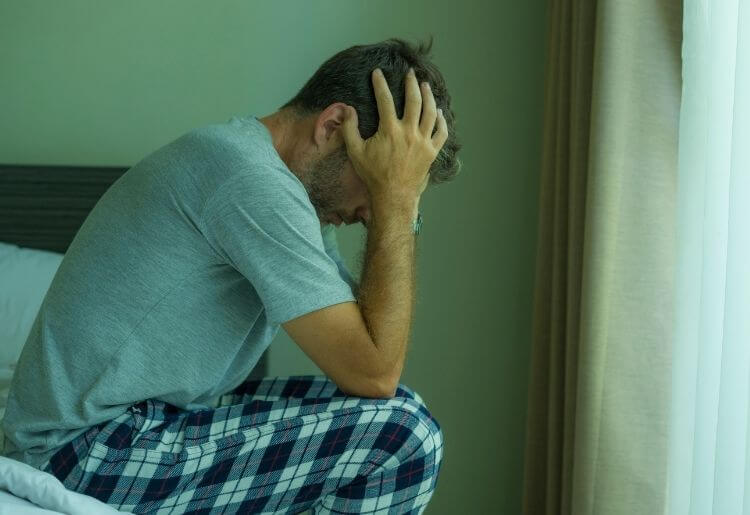Fortunately, there are ways to combat anxiety—both the symptoms and the root causes. Among them, therapy, either conducted in person or via a reputable online therapy platform, has been shown to be one of the most effective.
In this article, we looked at 10 signs and symptoms of anxiety disorders. If you recognize yourself or someone you love in any of them, it may be time to take action.
What Is Anxiety and What Is Anxiety Disorder?
Anxiety refers to a state of physical arousal associated with feelings of apprehension or dread. Physical arousal refers to the kinds of symptoms people usually experience when they’re anxious or nervous, like an increased or irregular heart rate, sweaty palms, trembling hands, or tense muscles.
Anxiety is a normal part of life, and it’s not unusual to feel some anxiety throughout your day in response to stressful situations, like a job interview or a first date. But when you start to feel anxious most or all of the time, have trouble identifying the source of your anxiety, or are simply unable to calm yourself down, it may indicate you have an anxiety disorder.
Anxiety disorders are diagnosed when the physical and mental symptoms of anxiety start to interfere with your daily life, and make it difficult or impossible to work, play, study, relax, or interact with friends and family. There are a few different types of anxiety disorders, and anxiety disorder symptoms can present differently for different people. Read through the symptoms below to learn more.
1. Excessive or incessant worrying
Excessive worrying refers to repetitive or unusually intense thoughts about potential problems—realistic or otherwise—without ever arriving at a satisfactory solution that helps you feel better.
People who experience excessive or incessant worrying are often plagued by unnerving what-if scenarios or reliving past events over and over again, focusing on negative or worrisome aspects and ignoring positive ones. Small, everyday problems take on mammoth proportions.
With an anxiety disorder, it’s not unusual to know intellectually that your thoughts don’t reflect reality and yet be unable to calm yourself down. This is particularly characteristic of generalized anxiety disorder (GAD), which affects 6.8 million Americans each year.
Importantly, worries of this kind respond well to cognitive behavioral therapy (CBT), like those offered by Cerebral and other online therapy platforms.
2. Restlessness and Agitation
Fidgeting, toe-tapping, thumb-rolling, and other nervous tics (small, repetitive movements) are all signs of agitation, and you may even exhibit them without being aware. The physical arousal associated with feelings of anxiety is caused by increased activity in your sympathetic nervous system, which controls your fight or flight response. Fidgeting and restlessness are a common manifestation of this—a way for the body to deal with all that nervous energy.
More extreme agitation can manifest as sweating, shaking hands, dry mouth, and headaches. Of course, not everybody who fidgets suffers from anxiety, and not everybody with anxiety will be restless. But if you find that you feel intense physical discomfort when you stop fidgeting, and that it worsens feelings of apprehension, it’s likely this is a symptom of an anxiety disorder.
It may also be a symptom of obsessive compulsive disorder (OCD), which can occur alone or alongside an anxiety disorder.
3. Insomnia
If uncomfortable, apprehensive thoughts keep you up at night and prevent you from falling or staying asleep, it may be a symptom of an anxiety disorder. Insomnia is its own distinct disorder, and doesn’t always co-occur with anxiety, but it’s a common occurrence nonetheless. Worse still, interruptions in your sleep schedule and overall fatigue can exacerbate anxiety disorder symptoms. Thus, the more anxious you are, the less you sleep, which makes you more anxious, and so on.
Anxiety disorders are also commonly associated with bad or strange dreams, which can cause people to wake up at odd hours of the night, and then have trouble falling back asleep. Insomnia can have an important negative effect on your wellbeing and overall health, so whether it’s associated with anxiety or not, it’s important to seek the help of a professional.
4. Fatigue
Of course, one of the obvious side-effects of insomnia is fatigue, but many people with anxiety disorders feel abnormally tired, foggy, and fatigued throughout the day, with or without insomnia. As mentioned before, the physical symptoms of anxiety are caused by excessive activity in your sympathetic nervous system, a kind of hyper-alertness that never ends. When this system stays active for long periods of time, it can lead to constant feelings of fatigue.
Of course, everybody feels tired from time to time. But excessive or ongoing fatigue that impacts your life and makes it difficult to do everyday activities is a common symptom of anxiety.
4. Inability to concentrate
An inability to concentrate on everyday tasks is a common symptom of anxiety (although it can also be associated with other disorders, like ADHD). This is one of the symptoms many people with anxiety disorders feel most impacts their life, because it makes it difficult or impossible to perform well at work or enjoy hobbies and pastimes.
If you experience an inability to concentrate without associated feelings of apprehension or nervousness, it’s unlikely that it’s due to an anxiety disorder. That said, it will still be worth checking out with a doctor or therapist, as it may be indicative of some other problem.
For many people with anxiety, an inability to concentrate also results in absentmindedness or forgetfulness, which in itself can be a source of anxiety and reinforce these negative feelings.
5. Irritability
Many individuals with anxiety also struggle with irritability, that is, being quick to anger or becoming easily frustrated. This has been shown to be especially true of teenagers and adolescents, with anxious teenagers being more irritable and volatile than their peers. But many adults also experience irritability in association with anxiety.
Irritability can color the way we perceive the world and the way we interact with friends and family, causing strain and conflict in relationships, which is itself a source of anxiety. Like fatigue, this is another vicious cycle, in which greater anxiety leads to greater irritability, and vice-versa.

6. Increased Muscle Tension
Feelings of danger and dread associated with anxiety trigger your fight or flight response, leading to increased muscle strain and tension. This can manifest as trembling in the hands or other body parts or intense headaches or pains in your neck, shoulders and back (where many people carry their tension).
If you tend to tense up the more anxious you feel, or you often notice that you’re particularly tense throughout the day without any real or immediate reason for it (that is, you’re in a constant state of readiness), it may be the symptom of an anxiety disorder.
One way to release muscle tension throughout the day is to practice relaxation techniques like meditations or breathing exercises. There are a variety of mediation apps to help guide you through these practices.
8. Social Avoidance
It’s not unusual for people with anxiety, especially social anxiety disorder (SAD), to avoid social situations and withdraw from the outside world. For such individuals, this can be one of the most painful aspects of their anxiety disorder. They may feel cut off from friends and family, and this isolation can dramatically increase feelings of anxiety.
It’s normal to feel a little nervous meeting new people or engaging in certain social activities, like going to a party where you don’t know many people, or having to talk in front of strangers, or even a big group of friends. But when social avoidance escalates to the point where you spend most or all of your time alone and feel utterly unable to cope with social situations, it’s most often associated with SAD.
Importantly, studies show social anxiety disproportionately affects members of the LGBTQ+ community. The overall strain associated with a (sexual) minority identity can lead to anxiety, depression, and other mental health issues. However, there are numerous online therapy platforms for LGBTQ+ individuals with licensed therapists that specialize in sexual and gender identity.
9. Shortness of breath or chest tightness
Feeling short of breath or like you have a weight on your chest is one of the most common symptoms of anxiety disorder. In some cases, it can lead to hyperventilation, but more often people experience it as a pervasive, long-lasting discomfort. Studies have shown a strong connection between anxiety disorders and labored breathing, so it’s no surprise this is one of the most commonly reported symptoms across all anxiety disorders.
Fortunately, it’s also one of the symptoms of anxiety that responds well to practices like meditation and mindfulness. Deliberately calming your breathing with certain breathing techniques can even have an immediate and lasting effect on other feelings of anxiety.
10. Panic Attacks
A panic attack is a period of strong, overwhelming anxiety and apprehension, accompanied by intense physical symptoms, such as hyperventilation, a racing heartbeat, trembling, sweating, light-headedness, and dizziness. People who experience panic attacks feel an uncontrollable sense of dread, as if something terrible is just about to happen. This feeling can last for minutes to hours, and may not respond to calming techniques like controlled breathing.
It is no doubt the most well-known symptom of anxiety disorders and, for many people, by far the most unsettling. The first time somebody experiences a panic attack, it’s not unusual for somebody to mistake it for a heart attack, so intense is the experience.
Unsurprisingly, panic attacks are what push many people to finally contact a therapist for anxiety.
Conclusion
Anxiety disorders are one of the most common mental health issues in the world, affecting some 10% of the population at any given time. If you experience any of the symptoms on this list regularly or in a manner that has a significant impact on your life, there are solutions available to you. The best way to know which coping strategies will work best for you, and the most effective way to combat both the symptoms and causes of your anxiety, is to work with a licensed therapist.
